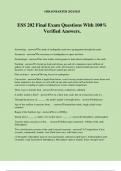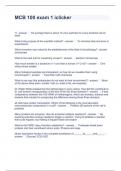©BRAINBARTER 2024/2025
ESS 202 Final Exam Questions With 100%
Verified Answers.
Seismology - answer✔The study of earthquakes and wave propagation through the earth
Seismicity - answer✔The occurrence of earthquakes in space and time
Seismologist - answer✔One who studies seismograms to learn about earthquakes or the earth
Fracking - answer✔To break up shale and release gas and oil; companies inject millions of
gallons of water, sand and chemicals into wells, the mixture is injected under pressure, which
fractures or "fracks" the shale and releases natural gas and oil
Plate tectonics - answer✔Driving forces for earthquakes
Convection - answer✔Heat a liquid from below, cool it on top (cooler material is more dense and
hotter material is less dense) so cool stuff on top sinks and warm stuff on bottom rises;
convection is tending to make everything have a more similar temperature
Three ways to transfer heat - answer✔Convection, conduction, radiation
Is earth's mantle a fluid? - answer✔Not on a short time scale, but on a long time scale it is
Through the process of ______, the earth's mantle is brought down. - answer✔Subduction
Age of the seafloor is measure from.... - answer✔Foraminifera study, single celled ocean
creatures
Range of the Seafloor Age - answer✔New to 200Mya
Strong layer (______), slides over weaker layer (______) - answer✔Lithosphere, asthenosphere
Tectonic plates are pieces of the.... - answer✔Chilled, rigid, outermost ~100km of the earth
(lithosphere)
Two classification systems of the earth's layered structure - answer✔(1) Composition: Crust
(oceanic, continental), mantle, core (fluid outer core, solid inner core)
(2) Strength: Lithosphere (part of crust and mantle, outermost rigid layer), Asthenosphere (part
of mantle, weak layer below lithosphere), Mesosphere (part of mantle, lower stronger layer)
, ©BRAINBARTER 2024/2025
Tectonic plates move ____ to ____ per year, this is about ____ to ___ per million years -
answer✔1 to 17 cm
10 to 170 km
It takes about ____ to ____ million years for the mantle to overturn - answer✔100 to 400
Evidences of Plate tectonics - answer✔Matching fossils from opposite sides of the world,
evidence from glaciation
Observations explained by plate tectonics - answer✔Relatively young age of ocean floor,
earthquakes (locations and types), volcanism (location and types), many aspects of biological
evolution-diversity vs. similarity of species
Earth's magnetic field has a ______ form. Field reverses at random intervals ranging from.... -
answer✔Dipole, (has north and south poles)
0.5 myr to 30 myr
Supercontinents - answer✔Pangaea (existed about 200 mya)
Godwana, Laurasia, Rodinia
Wilson Cycle - answer✔Cycle of continents coming together and drifting apart
Elasticity - answer✔Property of materials that deform when a force is applied and return to
original shape if the force is removed
Faults store energy slowly... - answer✔Over decades to centuries to millennia, but release the
energy rapidly in an earthquake, like a rubber band pulling on a block forward
Elastic Rebound - answer✔A fault remains locked (by friction) while stress slowly accumulates,
gradually twisting the rock, then it suddenly ruptures in an earthquake, releasing the stored-up
stress and energy is released in the form of heat and seismic waves
Ductile - answer✔Smooth motion in place and time, large-scale plate motions are smooth
Rock Formations: Boudinage - answer✔White layer, mostly straight
Rock Formation: Fold - answer✔White layer pretty curvy, mountains
Thrust Fault: Convergence - answer✔Horizontal Pressure (shrinking), compressive stress, one
side rises up against the other
Normal Fault: Divergence - answer✔One side rides down instead of up, stretching in horizontal
direction, fewer and smaller earthquakes at shallow depths, far from civilization, little damage
Most frequently: mid-ocean ridges





